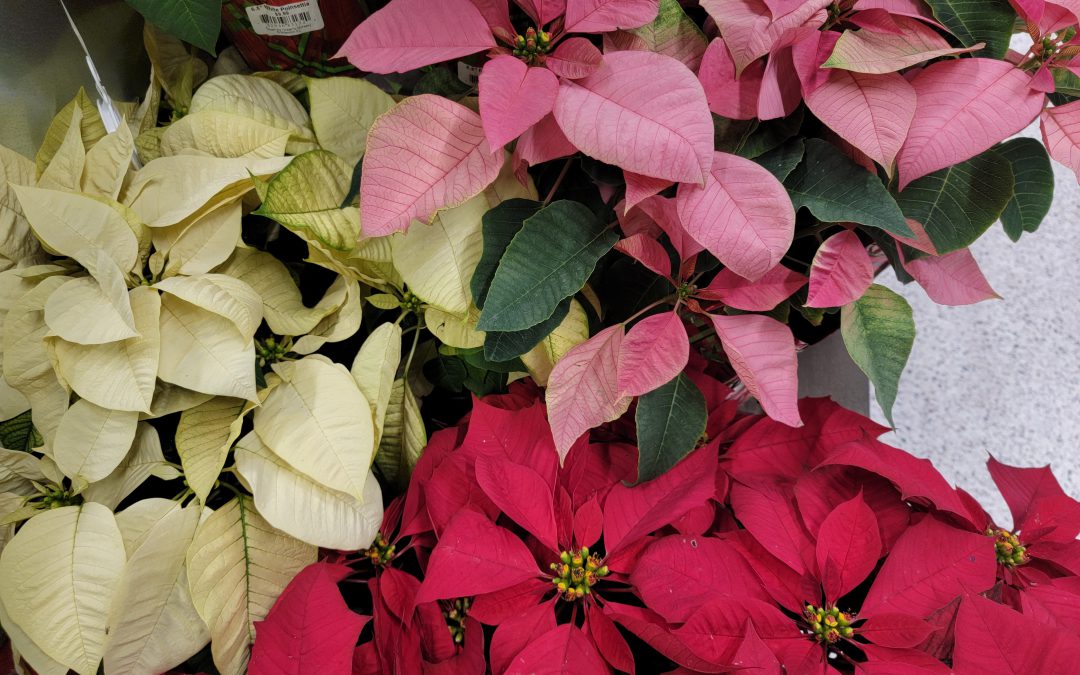
by Ray Bodrey | Dec 5, 2024
It’s getting close to that time of year again! You may be the giver or receiver of a wonderful holiday plant soon. Dish gardens, potted flowering plants (such as azalea, begonia, poinsettia, or chrysanthemum), plants with attractive foliage, and even patio citrus make great gifts. However, special care is needed to keep them healthy throughout the holiday season and beyond!
For plants intended to be “house plants”, over watering, over fertilizing and poor placement are the most common problems encountered by caretakers. The first thing you need to keep in mind about gift plants is that most of them have been growing in a carefully controlled greenhouse environment for some time. These types of plants are acclimated to a specific temperature & humidity level. Therefore, they’re sensitive. When they’re moved into your home atmosphere, they typically go into a level of shock. If you received a gift plant, you’ll have to help it overcome this shock by paying careful attention to the important factors- light, temperature, water, and fertilization.
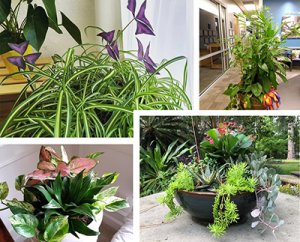
House Plants & Indoor Garden Examples Credit: UF/lFAS Communications
Indoor areas often restrict light and provide very low humidity. Plants with dense foliage prefer light, but not continuous direct light all day. Placing a plant near a window or near light fixtures should suffice for photosynthesis requirements. However, flowering plants such as mums and poinsettias will stand more light than most foliage plants and should be placed in very bright areas. Most indoor plants grow well in temperatures of 60 to 70 degrees. Be careful to not place plants in drafty locations where sudden changes in temperature occur. Also, don’t place plants close to radiators or air conditioner vents/returns. These areas typically dry soil excessively and could cause plants to wilt.
Watering is one of the major causes of failure with plants in the home, especially for containers which don’t have drainage holes. Most house plants will require a thorough soaking once a week. Water only when necessary and don’t let the pots stand in saucers of water unless the plants are very tolerant to excess water. Overwatering can kill plant roots, increase chances of disease, and eventually kill the entire plant.
Proper fertilization is another important part of growing healthy plants. Fertilizer labeled for house plants or 10-10-10 are good, general-purpose, complete fertilizers to use. Always follow all the directions on the bag or container, so that you don’t over fertilize, causing the plant’s demise.
Following these basic practices to keep house plants healthy should keep your gift plant looking attractive for the remainder of the holiday season and beyond.
For more information on house plants, please visit:
https://gardeningsolutions.ifas.ufl.edu/plants/houseplants/
https://gardeningsolutions.ifas.ufl.edu/plants/houseplants/indoor-gardens/
or contact your local county extension office for more information.
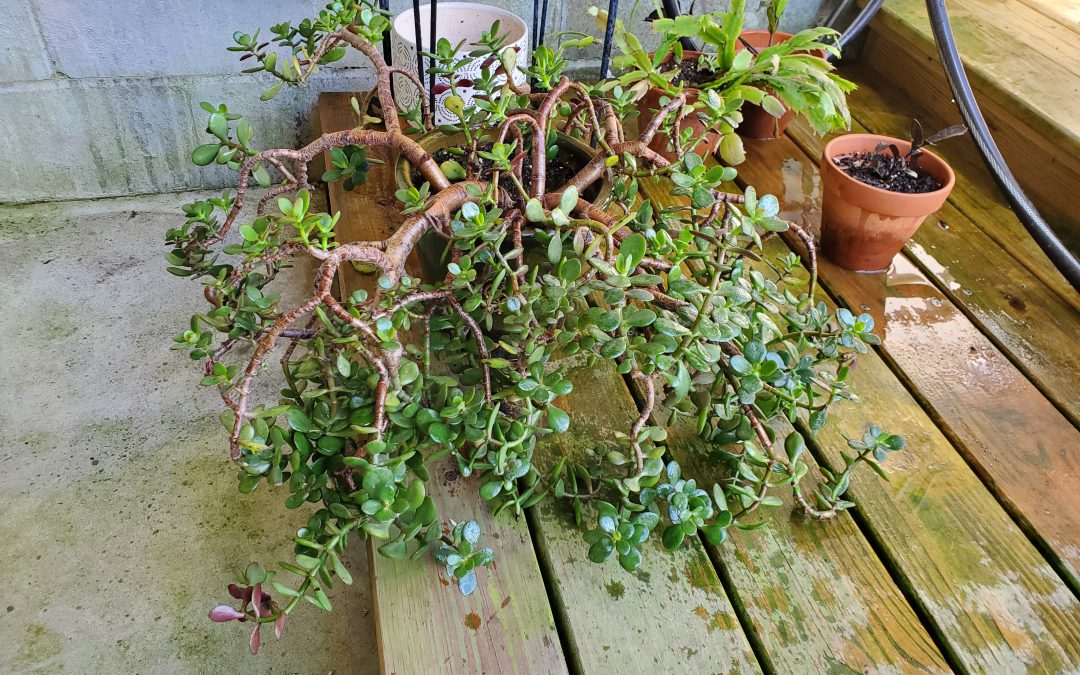
by Daniel J. Leonard | Jul 14, 2022
It seems like every time I pick up a home and garden type magazine, the cover photo is dotted with flowering orchids and indoor foliage plants that are inevitably in pristine condition. However, years of experience troubleshooting issues with both my own interior plants and those for clients tell a different story. All too often, indoor potted plants languish for years, barely alive, until they finally succumb. I’ve taken several to the plant graveyard just past the edge of the back yard because of this exact scenario. In recent times though, I’ve figured out a way to mostly avoid pitiful looking indoor plants – take them outside in the warm months!
To appreciate the perks of getting your indoor plants outdoors, it’s helpful to first think about why most interior situations aren’t very conducive to plant growth. There are three primary reasons houseplants fail: not enough light, improper watering, and low humidity. Most plant species grown for interiorscapes hail from the tropics where they grow in the understory of large trees, receive bright, filtered sunlight, and experience abundant moisture and humidity. These conditions are VERY hard to mimic in the typical American house unless you huddle all your plants near windows, take steps to increase humidity (which doesn’t play super well with furniture and other household items), and really tune in your watering. Taking indoor plants outside to play in the Panhandle summers just really makes the whole situation much easier!
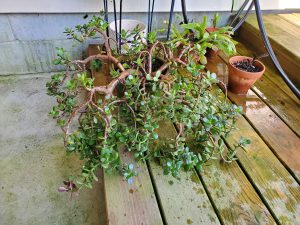
A Jade Plant that had languished indoors during the winter beginning to perk up outside! Photo courtesy of Daniel Leonard.
Now that you’ve made the decision to move your indoor plants out, figuring out where to site them is the next step. I’ve found that, with few exceptions, houseplants prefer to be in a bright area but away from direct sunlight – under mature trees, on a covered porch, anywhere that doesn’t get direct sunlight will do! It is also a great idea to place plants near a watering source. If a hose doesn’t easily reach the spot or it’s inconvenient to tote a watering can to them, your plants won’t get watered regularly and will suffer. You’ll be surprised how much water plants use when they’re in conditions conducive to growth so be sure to check pots every couple of days to prevent droughty conditions! Once in these new and improved growing conditions, your houseplants will also respond very well to a little extra fertilizer. A good general prescription is a topdressing of a slow-release fertilizer using the recommended label rate as soon as you bring them outside and following that up once each month with a supplemental liquid fertilizer.
Keeping houseplants happy in the Florida summer is easy and begins with getting them outside. Find a spot with bright, indirect light, keep them watered well, add a little fertilizer, and watch them grow like they never have before! For more information on growing houseplants or any other horticultural or agricultural topic, contact your local UF/IFAS County Extension office. Happy gardening!
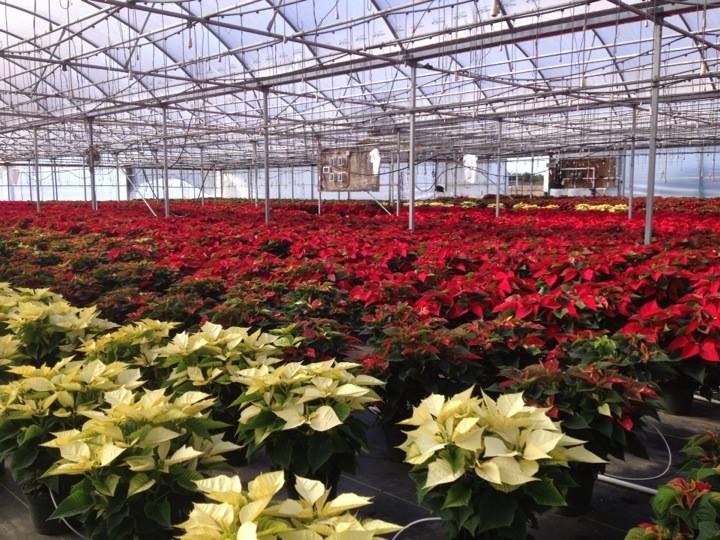
by Eddie Powell | Dec 9, 2014
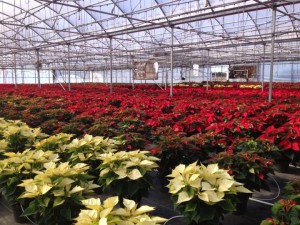
Poinsettia grown in greenhouse
Photo Credits: William Wendt
The poinsettia is a beautiful plant associated with the Christmas holidays. These plants create colorful holiday decorations for any home. After the holidays are over, they can be used as landscape plants.
Poinsettias are non-poisonous and non-toxic. However, some people may be sensitive to the latex in poinsettia sap. Although eating even a large number of leaves will not result in illness, the plant is not considered edible. When used as an indoor plant, it should be kept out of reach of children and pets.
Keep your poinsettias away from drafts and chilly air. Water your poinsettia when the surface of the soil is dry to the touch. Place a saucer under the pot, and drain the saucer if water starts to collect in it. Keep the soil from getting soggy. Gently spray the plants with a mist sprayer or place them on gravel trays. Slightly humid air will help prolong the plants’ color and life span. Do not fertilize your indoor poinsettias until you are ready to move them outside. High levels of fertilizer will reduce the quality of the plant.
When the temperatures start to warm up in spring, trim the fading bracts. Leave 4 to 6 inches of the stem on each branch. Begin using a well-balanced fertilizer, and move the plant outdoors to a somewhat shaded area. Once the poinsettia has acclimated to the outdoors, plant it in an area that receives full sun most of the day. Keep in mind that to put out its colorful bracts, poinsettias require 14 hours of complete darkness each day for 6 to 8 weeks. Any interruption to this dark period can delay or prevent the plant from flowering.
Keep the soil moderately moist at all times. Poinsettias grow best in moist, well drained, fertile soils. The ideal soil pH range is 5.5 to 6.5, but the plants will tolerate a range from 5.0 and 7.0. Fertilize your outdoor poinsettias once a month. In north Florida, the plants should be fertilized between May and September.
In the landscape, prune your poinsettias in early spring after they are finished blooming, and when the danger of frost has passed. Cut them back to within 12 to 18 inches of the ground. If the plants have been frozen below this point, cut them back to the live wood. Pruning during the growing season will produce a compact plant at flowering time. After four weeks or when the new growth is 12 inches long, cut the plant back, leaving four leaves on each shoot.
For more information see: Poinsettias at a Glance
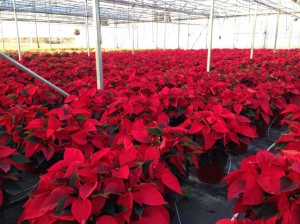
Poinsettia offers awesome Christmas color
Photo Credits: William Wendt







